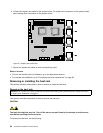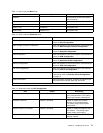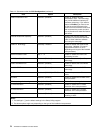
If the server cables and connector panel have color-coded connectors, match the color of the cable end with
the color of the connector. For example, match a blue cable end with a blue panel connector, a red cable
end with a red connector, and so on. See “Rear view” on page 10 for an illustration of the I/O connectors on
the rear of the server.
Turning on the server
When the server is connected to an ac power source but is not turned on, the operating system does not
run, and all core logic except for the service processor (the integrated management module) is shut down;
however, the server can respond to requests to the service processor, such as a remote request to turn on
the server. The power-on LED ashes to indicate that the server is connected to an ac power source but
is not turned on.
Approximately ve seconds after the server is connected to ac power, one or more fans might start running
to provide cooling while the server is connected to power and the power-on button LED ashes quickly.
Approximately one to three minutes after the server is connected to ac power, the power-control button
becomes active (the power-on LED ashes slowly), and one or more fans might start running to provide
cooling while the server is connected to power. Then, you can turn on the server by pressing the power
button on the front control panel. See “Front control panel” on page 11
.
Updating the server conguration
When you turn on the server for the rst time after you add or remove a device, you might receive a
message saying that the conguration has been changed. The Setup Utility program starts automatically
so that you can save the new conguration settings. For more information, see Chapter 6 “Conguring
the server” on page 69
.
Some optional devices have device drivers that you must install. For information about installing device
drivers, see the documentation that comes with each device.
The server comes with at least one microprocessor. If more than one microprocessor is installed, the server
can operate as a symmetric multiprocessing (SMP) server. You might have to upgrade the operating system
to support SMP. For more information, see the operating-system documentation.
If the server has an optional RAID controller and you have installed or removed a hard disk drive, see the
documentation that comes with the RAID controller for information about reconguring the disk arrays.
Turning off the server
When you turn off the server and leave it connected to ac power, the server can respond to requests to
the service processor, such as a remote request to turn on the server. While the server remains connected
to ac power, one or more fans might continue to run. To remove all power from the server, you must
disconnect it from the power source.
Some operating systems require an orderly shutdown before you turn off the server. See your
operating-system documentation for information about shutting down the operating system.
66 ThinkServer Installation and User Guide


















